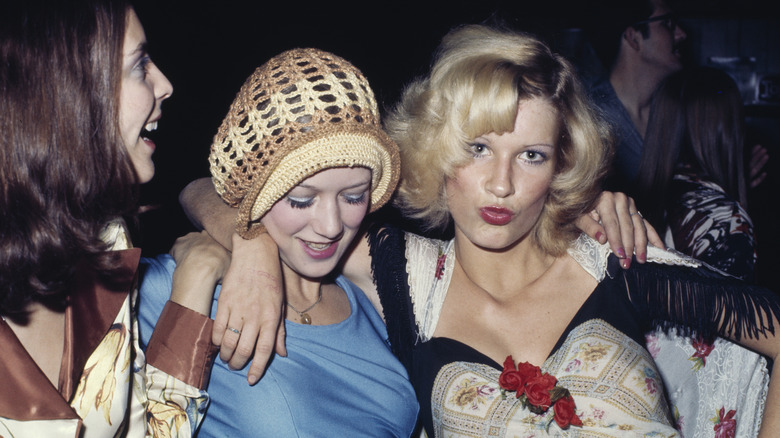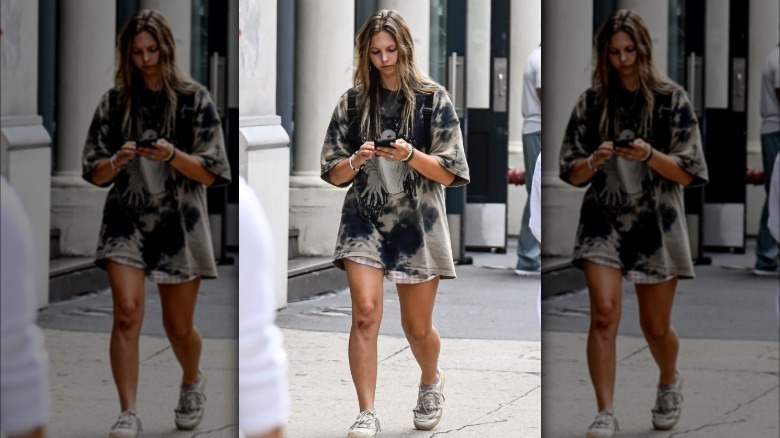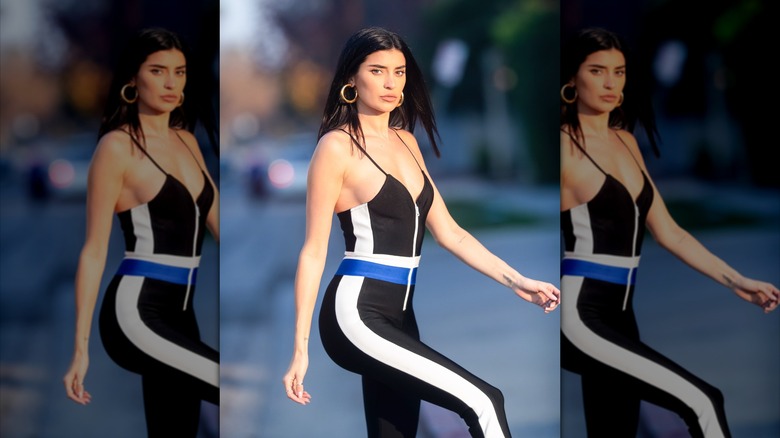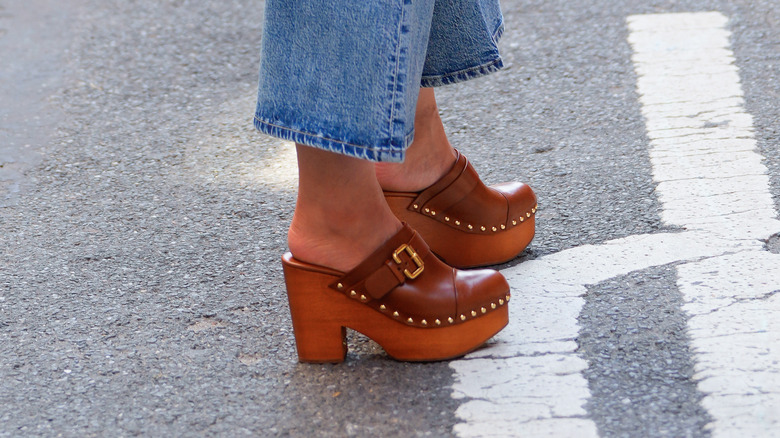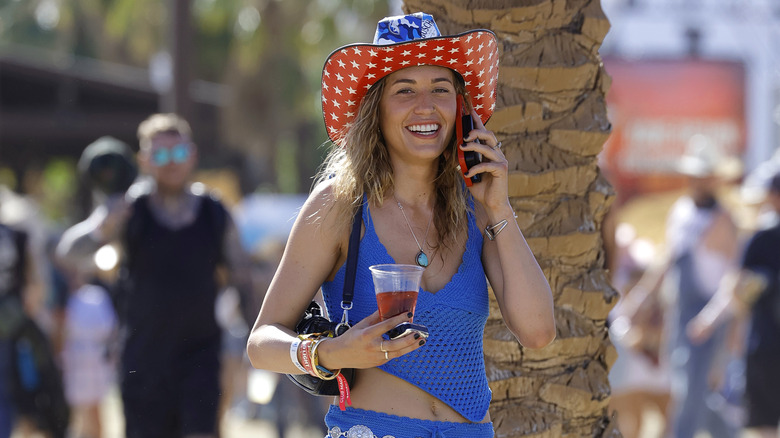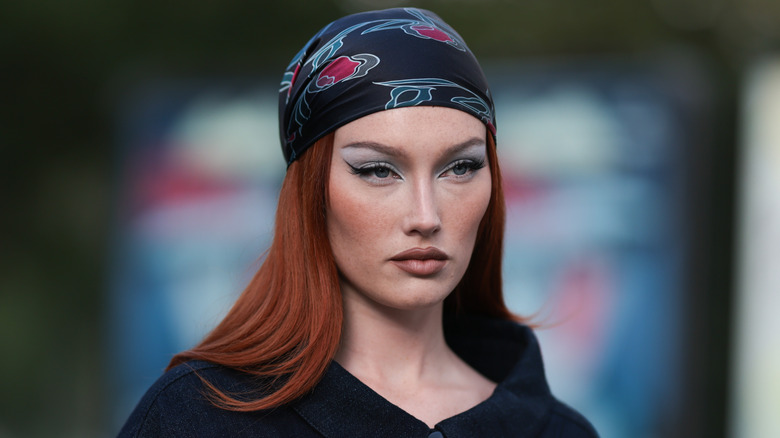Things People Actually Found Attractive In The '70s
Looking back at the past can provide some of the best inspiration for today's fashion, and it can certainly hint at tomorrow's trends. This year, for example, has been all about blending historic fashion eras to get the best of vintage style in a single cohesive 'fit. When we look back to the 1970s, otherwise known as the decade of disco, there are fashion lessons to learn, along with those we're more than happy to leave behind.
A lot went on in this definitive era that resulted in long-lasting changes on popular culture as a whole. On the entertainment front, which naturally fed the fashion world and vice-versa, the '70s brought us the death of Elvis Presley, the unstoppable reign of Aretha Franklin, and the beginnings of Queen. Along with Freddie Mercury's bohemian androgynous sparkling jumpsuits, we saw bell-bottom jeans on Pam Grier, hooded gowns and plunging necklines on disco queen Donna Summer, and kaftan dresses on Elizabeth Taylor.
Beside these staples, fashion at the time was marked by trends that may seem foreign to Gen Z — think chunky clogs used to boogie the night away and groovy tie-dye co-ords left over from the Hippie era. But one thing's for sure: No trend is ever really dead and gone. Even the most unpalatable styles will come back in some iteration sooner or later, so these '70s looks are bound to rise again (if they haven't already).
Tie-dye was a force in the '70s
Up until the 2020s, tie-dye had scarcely been seen since its prime time in the 1970s (other than a short-lived comeback in the '90s). This trend is part of the psychedelic aesthetic that was massive in the late '60s, slowly building in popularity and then blowing up after icons of the era, including Janis Joplin, donned the look at Woodstock in '69. Having briefly experienced the trippy amalgamation of colors in the '90s, millennials may associate tie-dye with childhood summers worlds away from en-vogue fashion trends. So, naturally, we all fell off our chairs when a reiteration of the tie-dye craze emerged last year. This modern take saw fashionistas rocking the blended pattern in muted shades, leaving colorful options for activewear and accessories.
In the '70s, tie-dye was particularly prominent at music festivals, appearing on dresses, jumpsuits, and co-ords. Adopted by the Hippie movement, it remained a popular trend through the early years of the decade, eventually dying down with the other staples of psychedelic style.
Spandex was a disco diva go-to
If there's one trend we're grateful didn't last through the ages, it's spandex (a generic stretchy material of which one of the most famous producers is Lycra). We do get it; this fabric was a no-brainer for the disco years, but it didn't die there. Spandex survived well into the 1980s, becoming the go-to for gym looks before being mostly forgotten in the '90s — at least beyond the realms of activewear.
In the '70s, spandex was a staple of the clubbing scene, as the idea was to wear body-hugging attire that allowed you to really groove. It often came in the form of bodysuits or jumpsuits, tight tops, and short-shorts or hot pants (another '70s trend that's reared its head in modern times). Beyond spandex, other essential elements of the disco look included platform heels and, of course, glitter and sequins. We do still see this fabric in our activewear, but we're yet to have a spandex explosion filtering into our wardrobes in the 2020s. That doesn't mean it can't happen, though. Hot pants aren't going anywhere this year, so anything from the '70s is fair game.
Icons of the '70s went hard with clogs
Clogs date back to well before the 1970s, with early wooden versions first being recorded in the Netherlands in the 13th century. Naturally, this historic footwear had adapted significantly by the time it rose to popularity in the '70s, but the chunky silhouette remained the same. Worn by the likes of Stevie Nicks and other A-list musicians of the era, clogs are similar to mules — a shoe that's much more familiar to millennials and Gen Z — but feature a bigger platform beneath the sole. Mules, on the other hand, are an ideal all-purpose shoe, as they tend to have a flat sole and can come with any height of heel.
These were worn by men and women alike, aligning with the platformed footwear ideal that dominated the decade's aesthetic. We've seen spikes in the popularity of clogs throughout the 2020s, but we're yet to see the sky-high clogs that ruled the '70s (and possibly led to a few broken ankles) make their way fully back to the mainstream.
Crochet tops ruled the '70s
The 1970s served as the backdrop of the second-wave feminist movement, which first emerged in the late '60s. Sexual equality and freedom were key concepts being embraced by women around the world, and this marked a move from the conservative standards of 1950s fashion to more daring and liberated looks. The movement paved the way for garments like the breezy crochet top to become super popular, as it was one of the many options that gave women the freedom to dress comfortably and have fun with their fashion without worrying about meeting modesty standards. But tops weren't the only garments that were crocheted; this popular stitching found its way to everything from jumpsuits to bikinis throughout the decade.
This style of stitching is one '70s trend that has definitely emerged again in the modern era, with trendy crochet pieces having taken over summer 2023 and remained en vogue through last fall. Fast-forward to this spring and summer, and crochet skirts in particular have been everywhere.
Pastel eyeshadows were off the chain
In terms of trendy 1970s makeup looks, beauty reflected disco fever in a big way. Think shimmery eyes, luminous lips, and twinkling highlights. This sparkly aesthetic is still commonplace today, but one signature '70s look that you won't see in modern times without the "vintage" tag is pastel eyeshadow. We still get hints of frosted eyes returning to popularity in the 2020s — the pastel eyeshadow craze that broke up 2023's Barbiecore comes to mind. But again, this is always described with "vintage" or "throwback" disclaimers. Periwinkle blue hasn't been viewed as a true eyeshadow staple since the '70s, when it ruled alongside white liner and unruly brows.
Perhaps the most famous face to popularize pastel-blue eyeshadow was it-girl Twiggy, who often wore the look with her signature bold, feathered lashes in the '60s and '70s. Though we can appreciate this look from a historical perspective, it's difficult to imagine pastel eyes being the go-to for an entire decade, but that's the case with all trends. After all, future generations will more than likely look back at the concealer lips of the 2000s or 2023's negative space eyeliner and wonder what the heck we were thinking.
